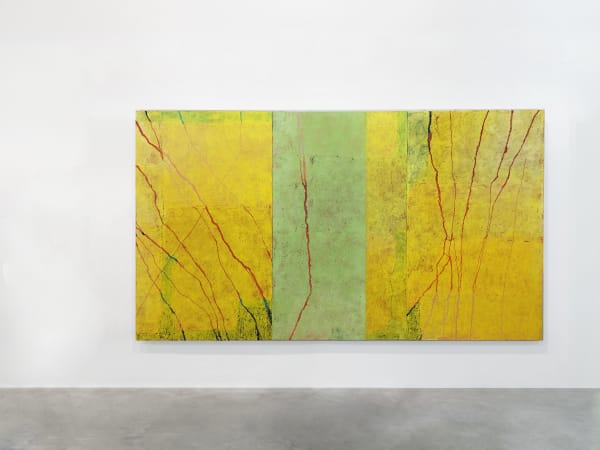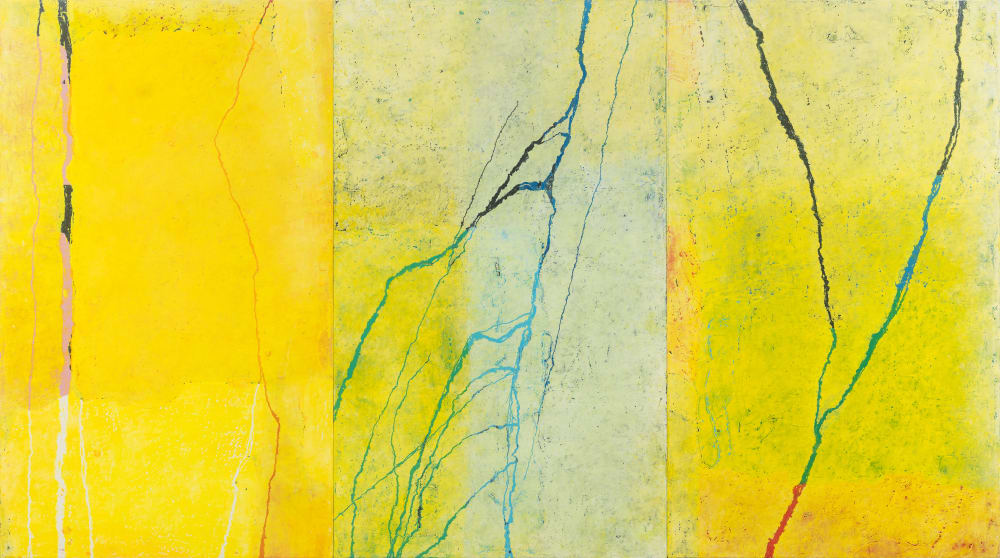SENKRECHT DURCH DEN AUGENBLICK: PACO KNÖLLER
-
Introduction
Vertical, as in right-side up or upside down. It may be a matter of perspective; a position in relation to something else. The title of Paco Knöller’s exhibition, Senkrecht durch den Augenblick (Vertically through the Moment), indicates a direction, a relationship, a motion—a moving through. The artist’s sixth solo exhibition at Galerie Thomas Schulte presents recent works in oil crayon and lacquer on wood, including multi-panel large-formats that pull in multiple directions at once. The works move between drawing and painting in a symbiosis of color and line—unfurling vast color worlds and their changing atmospherics.
A vertical motion, like a lightning strike. For Knöller, lines are energetically charged, like electric currents. We feel this intensity in the triptych opus 2. Here, the working title zentrieren (Centre) suggests not just a physical position, but also a mental one—a focus, finding balance and harmony, being present in the moment. With mostly vertical lines that shoot and splinter up and down its panels, it reminds not only of lightning or electricity, but also tree branches wavering in a breeze. Any storminess is offset by the luminous yellow that sprawls over it like a mist, coalescing with vaguely geometric fields of muted blue and green. Like the full spectrum of light from the sun, this flood of yellow contains multiple colors, even beyond the immediately visible. The effect is similar in opus 1, in which the vivid lines are primarily red and vein-like, shifting to deep blue in some places and fading out in others, as though seen under skin, life coursing through them.
River systems, as seen from a bird’s eye view, also come to mind—a perspective that is hinted at in another work: unter mir der Himmel (The Sky Below Me), an impossibly vibrant, expanding and contracting cosmos that spans two horizontal panels. To say the contrast between it and the two opus triptychs is like night and day would be an oversimplification. Even this all-consuming black space is not impermeable to the fields of blue, red, and pink that glow like color filters held over a hidden light source. Whether these colors spill over or shine through from underneath the black layer is not immediately clear, as the resulting light is diffuse. The dry matteness of the black oil crayon produces the porous texture and chalky, granular appearance that facilitates its shimmering effect. While the circularity of the multicolor lines in chaotic swirls and the solid blue ellipse that opens in one corner offer wormholes to journey through.
This cyclonic motion is magnified in jetzt (Now), a rich, red single-paneled work. In it, a black spiral burrows just off center and is left open at the outer edge, as though accumulating size and force to suck us in. Its title is a call to action. It snaps its fingers at us, while sending things tumbling into motion. It’s a moment of change, but also something continuous, gradual, growing, as well as dizzying and potentially overwhelming. Yet another vertical motion. Like being upside down underwater, the sky growing distant under your feet.
Here, the shifts in color expose bright flecks in the surface that darken around the edges, tinged with inky residue like burning celluloid film. Once again, simply referring to the work as ‘red’ proves insufficient—not only because of the plurality of reds it contains. Its ground also recalls a kind of meteorological radar, measuring shifts in phase, changes in temperature—below, an incandescent orange-red, above, icy undertones of blue. A change in conditions that can send a shock to the system.
It’s this pulse that runs through the works in the exhibition. Referring to abrupt stops, for example in unter mir der Himmel, where lines suddenly break off at the seam with no intention of continuing into the adjacent panel, Knöller likens the effect to that of reading a poem. Its unexpected line breaks and interrupted thoughts are an activating force, prompting a continuous perceptual change.
This is also reinforced by the ambiguity rooted in the works’ making: in complicated relationships between over and under, and processes of adding to and taking away. Through a slow and layered approach, Knöller spreads oil crayon over a multicolored lacquer ground applied to a wood panel. When lines are not extracted by knife, opening the top layer like skin to release the underlying color, they are alternatively drawn on top using an oil crayon of another color. Sometimes the lines drawn over pick up precisely where those exposed from underneath left off, flowing together seamlessly. Lines also blur, split, trail off, and bleed into the surrounding space. This overall porousness is heightened by the liquidity built into the works’ surface—in bubbling droplets of lacquer, in fluctuations, in spots of color resembling water stains. A fluidity that allows line and color, organic and geometric to synthesize.
Within this constellation, small marks and fingerprints are also visible: traces from hands and tools. The physicality of the artist’s movements resonates in our experience of the work. As we are thrust into the current, we extend ourselves to meet it, following its lines and untangling our own patterns of thought. Whether the sky is above or below, the implied verticality remains limitless. And, as Knöller points out, it’s precisely this feeling of infinity that creates the possibility of falling—like the fall into sleep that jolts us awake.
Text by Julianne Cordray
-
Works
-
Installation Views
-
Inquire about works by Paco Knöller

-
Video
-
Artists on view















